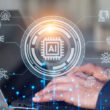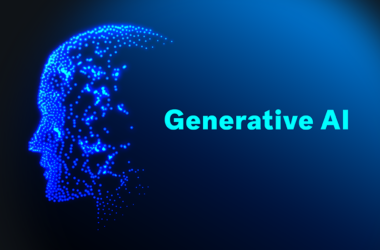Generative AI trends started to take off in 2012, with various AI framework tools launched in many industries. Now, more than a decade later, AI has changed the workflow of businesses!
We have AI Powered tools, services, and even analysis to understand customer perception. Machines are no longer limited to performing computational tasks; they are now evolving as creative collaborators.
Just imagine a world where the creation of AI-powered drug discovery, personalized 3D-printed prosthetics, or custom-generated soundtracks for your movie night are no longer hypothetical. Indeed, 2024 will be another banner year for generative AI services.
The possibilities and potential for generative AI are endless. In fact, the global generative AI market is expected to skyrocket to $5.1 billion in various industries, from healthcare to entertainment. As we explore the transformative power of generative AI services, we must consider responsible development, ethical applications, and human-centered collaboration as important.
Generative AI’s Role in Content Creation
We have stepped into a new world where content creation is led by generative AI. It’s a transformative force redefining the very essence of the creative process.
We live in a world where AI adds its innovative touch to everything. From managing regular social media posts to creating marketing campaigns and even writing film scripts, there are traces of AI everywhere. This vision is not for writing alone; it envisions using AI-generated prompts to overcome creative blocks.
Even musicians are collaborating with AI to create melodies, and designers are exploring fresh concepts through AI-powered prototypes.
This is not some random trend; it has become a reality! In the world of marketing, we now have generative AI trends that customize product descriptions and tweak ads in real-time for each user.
News outlets are evolving to automate report drafting, freeing up journalists for more in-depth analysis. Just look at the field of education; AI is transforming how we learn, creating personalized materials that adapt to individual students’ pace and skill levels. It’s truly amazing how technology is changing the game!
But there’s no need to worry just yet! Generative AI isn’t developed to replace human creativity; it’s a modification. It acts as a potent ally for content creators and anyone seeking to captivate audiences with compelling narratives.
The future of AI technology in content creation is bright and promising as we step into the next chapters of innovation and collaboration.
Boosting Productivity with Generative AI Integration
We have taken a leap in productivity with generative AI solutions. This leading powerful tool is transforming the way we work by automating tasks, streamlining processes, and giving us more time for creative thinking.
With generative AI services, we can craft marketing copy that not only grabs attention but converts, designing personalized emails or even creating product mockups specific to our needs.
Let’s take a real estate agent, for example, who is juggling social media demands and finding the right person for the listing. With generative AI predictions, they can effortlessly generate eye-catching posts showcasing properties, respond to inquiries with a personal touch, and even whip up virtual tours.
The result? A significant boost in reach and efficiency, allowing them to zero in on closing deals.
The impact of generative AI on industries other than real estate as well is no doubt a wave of creativity. From predicting customer behavior to automating data analysis, it has improved productivity and streamlined operations.
Significance of Prompt Engineering in Generative AI Development
In 2024, Generative AI trends will be more than just a skill partner for our business; it will be an extraordinary creation that relies on precise instructions. However, we need engineers who are skilled in a multitude of areas that shape the foundation of generative AI models.
AI alone cannot make data relevant; it needs an expert who understands the valuable data and trains the model to produce results like training AI systems to create new content, such as images, videos, or text, by learning from existing data and deep learning AI detect insights.
Prompt engineering in generative AI development services is not just a necessity, but its impact extends far beyond producing immediate outputs. It serves as a driving force behind the evolution of AI models themselves.
With the right prompt engineering, AI models can continuously learn from new data and adapt to changing environments. Moreover, prompt engineering can make sure that AI systems are not only accurate but also ethical.
As AI becomes more advanced and integrated into various aspects of our lives, it is crucial to have engineers who understand the potential bias and ethical implications of AI algorithms. To analyze performance, they can gain insights into model strengths and weaknesses and facilitate ongoing training and refinement.
Importance of Diverse AI Stacks
There’s a fresh generative AI trend taking center stage: the rise of diverse AI stacks. From industries to services, AI has become a home assistant. It has integrated into our daily lives, from virtual assistants like Siri and Alexa to self-driving cars.
However, there is growing concern about diversity and inclusion in AI development. First, let’s understand what diverse AI stacks are.
They refer to the tools, algorithms, datasets, and programming languages used in building an AI system. Imagine that instead of relying on a single tool, teams of experts collaborate, each specializing in their own field–data science, linguistics, engineering, etc. Their combined expertise comes together to tackle complex problems. That’s the core of a diverse AI stack!
By combining specialized models such as image recognition, natural language processing, and generative engines, we create a powerful force that examines the world from various perspectives, revealing patterns and connections that a single model might overlook.
This diversity reduces biases and errors, building trust. Like a safety net, they ensure accurate, responsible results. It’s like having a safety net made from different threads, catching potential issues, and ensuring accurate, responsible results.
Generative AI’s Impact on Artistry
The artistry has been profoundly transformed by AI. It has changed the creative process and production methods of artists and the way it is experienced and appreciated by audiences.
We can see emerging generative AI advancements having tremendous growth and development in recent years. Originally, creating art was considered a solely human endeavor. However, machines are now able to generate creative illusions and art that can express emotion.
This has led to a new way of collaboration between humans and machines, where artists can use AI algorithms to enhance their creativity and push the boundaries of what was previously thought impossible.
But now, artists can explore new styles, techniques, and ideas that they may not have been able to imagine on their own. One recent example is the rise of AI-powered art platforms like Dream by WOMBO, NightCafe Creator, and Artbreeder. With these tools, anyone can input ideas or pictures, and the AI will transform them into unique, dreamy creations.
Moreover, generative AI isn’t out to replace human artists; it’s here to make their voices louder and broaden the canvas of artistic expression. It’s a powerful tool, not something to be afraid of.
So, whether you paint or compose, the world of generative AI is waiting for you, ready to co-create a masterpiece blending human and machine creativity that will redefine art for generations to come.
Redefining Writing Processes through Generative AI Assistance
As we move forward with AI trends across industries, writing is no exception. The emergence of generative AI services has transformed how we approach and engage with the writing process.
Writing was seen as a solitary activity that required one’s undivided attention and creativity. With the emergence of generative AI, writers have a powerful new tool to help them in the writing process.
For instance, writers can get ideas and develop new concepts, creating outlines and structures for written pieces. Basically, it provides a framework for writers to build upon.
Tools like ShortlyAI and Jasper AI become writing partners, suggesting styles, generating perspectives, and providing grammar feedback. They can’t capture all human styles yet, but they are learning and learning fast.
Challenges in Embracing Generative AI Trends
The future of Generative AI technology might appear bright, but there are some downsides to the technology as well. AI models are complex and require significant computing power. By acknowledging these hurdles and investing in robust strategies, we can pave the way for innovation.
Ethical and Societal Challenges
Generative AI’s use of expansive data sets for training raises pivotal concerns. These include copyright infringement and potential inaccuracies. These issues are particularly significant in sensitive fields like media, where trust and credibility in AI-generated content are at stake.
The advent of deepfakes and AI-generated misinformation poses a substantial threat. This is especially true in critical areas like elections and social media. Addressing these challenges requires robust detection methodologies and comprehensive ethical guidelines.
The inherent bias in training data can unintentionally be amplified by generative AI models, leading to discriminatory or unfair results. Ensuring fairness necessitates effective strategies for bias detection and mitigation.
The automation capabilities of generative AI also raise concerns about future job displacement. This highlights the need for proactive reskilling and upskilling initiatives.
Technical and Practical Challenges
Transparency is a key challenge in generative AI models. Understanding their processes is crucial for trust and identifying biases or errors. However, present models often have opaque decision-making processes, making interpretation difficult.
Resource constraints pose another hurdle. Training and operating large generative AI models require significant computational resources and energy, which can be prohibitive for smaller organizations and individuals. Overcoming this barrier requires more efficient and only the best generative AI solutions.
Data privacy and security are also vital considerations when handling sensitive data for training and operating generative AI models. Implementing robust data security measures and privacy-preserving training techniques is essential for responsible adoption.
Addressing ethical concerns, safety risks, and potential misuse requires clear and adaptable regulations in the face of rapid advancements in generative AI. Developing a comprehensive global framework for responsible development and deployment of AI continues to be a challenging task.
Conclusion
Embracing generative AI is key to shaping the future of content creation, art, and writing. However, challenges such as bias, interpretability, and accessibility still need to be addressed.
By investing responsibly and in human collaboration, we can access and understand its techniques. AI can be our personalized assistant, with hyper-realistic virtual worlds and artistic collaborations – a new part of boundless creativity.
Frequently Asked Questions (FAQs)
What Industries Are Benefiting Most from Emerging Generative AI Trends?
Industries that benefit from generative AI trends the most, include healthcare, entertainment, and design, where AI is used for drug discovery, content creation, and prototyping.
How Can Businesses Integrate These Trends into Their Existing Processes?
Businesses can easily integrate any trend just by adopting Generative AI solutions from a reputable company like Folio3 AI, which offers AI-powered tools, enhancing workflows, and staying agile in technology.
Are There Any Privacy Concerns Related to These Advancements?
Yes, public security is important, but AI has raised some, requiring robust data protection measures and ethical guidelines to address the potential misuse of generative AI.
How Do These Trends Affect Job Roles in the Tech and Creative Industries?
No, it doesn’t affect job roles, but trends reshape industries, demanding upskilling for tech and creative professionals and emphasizing collaboration between humans and AI.
What Safeguards Are in Place to Ensure the Responsible Use of Generative AI?
Safeguards include diverse teams, transparent algorithms, and guidelines, which are needed to ensure the responsible use of generative AI, mitigate bias, and uphold accountability.










